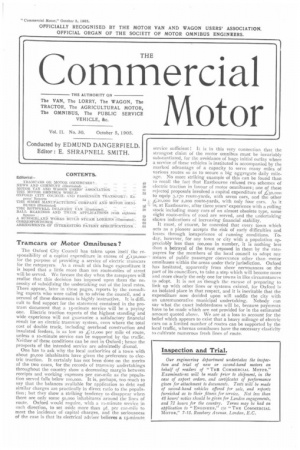Tramcars or Motor Omnibuses ?
Page 1

If you've noticed an error in this article please click here to report it so we can fix it.
The Oxford City Council has taken upon itself the responsibility of a capital expenditure in excess of
for the purpose of providing a service of electric tramcars for the ratepayers. As a result of this huge expenditure it is hoped that a little more than ten route-miles of street will be served. We foresee the day when the ratepayers will realise that this decision has imposed upon them the necessity of subsidising the undertaking out of the local rates. There appear, later in these pages, reports by the consulting experts who were called in to advise the council, and a Perusal of these documents is highly instructive. It is difficult to find support for the statement contained in the protram document that a Is-minute service will be a paying one. Electric traction experts of the highest standing and wide experience will not guarantee a satisfactory financial result for an electric tramway system, even where the total cost of double track, including overhead construction and insulated feeders, is as low as ,-12,000 per mile of route, unless a eo-minute service can be supported by the traffic. Neither of these conditions can be met in Oxford; hence the prospects of the intended service are admittedly dismal. One has to ask why the local authorities of a town with about so,000 inhabitants have given the preference to electric traction. It certainly has not been done on the merits of the two cases, for the records of tramway undertakings throughout the country show a decreasing margin between receipts and working expenses per car-mile as the population served falls below 'mom It is, perhaps, too much to say that the balances available for application to debt and similar charges are practically in direct ratio to the population; but they show a striking tendency to disappear when there are only some so,000 inhabitants around the lines of route. Oxford would require, with a t.a-ininute service in each direction, to set aside more than td. per car-mile to meet the incidence of capital charges, and the seriousness of the case is that its electrical adviser believes a 15-minute service sufficient ! It is in this very connection that the strongest claim of the motor omnibus must be invariably substantiated, for the avoidance of huge initial outlay where a service of these vehicles is instituted is accompanied by the marked advantage of a capacity to serve many miles of various routes so as to secure a big aggregate daily mileage. No more striking example of this can be found than to recall the fact that Eastbourne refused two schemes of electric traction in favour of motor omnibuses; one of these rejected proposals involved a capital expenditure of ,4.30,000 to equip 3,170 route-yards, with seven cars, and the other ,e.;20,000 for 2,200 route-yards, with only four cars. As it is, at Eastbourne, after three years' experience with a rolling stock including many cars of an almost obsolete type, some eight route-miles of road are served, and the undertaking shows indications of increasing financial stability. It must, of course, be conceded that every town which acts as a pioneer accepts the risk of early difficulties and losses through inexperience of running conditions. Today, however, for any town or city with a population appreciably less than loo,000 in number, it is nothing less than a betrayal of the trust reposed in them by the ratepayers for the members of the local council to adopt any ' means of public passenger conveyance other than motor omnibuses within the areas under their jurisdiction. Oxford has hesitated, apparently from sheer nervousness on the part of its councillors, to take a step which will become more and more clearly the only one for towns in like circumstances to adopt. It is not as though the excuse of preparing to link up with other lines or systems existed, for Oxford is an isolated place in that respect, and it is inevitable that the expenditure now decided upon will saddle the city with an unremunerative municipal undertaking. Nobody can say what the exact indebtedness will be, because payments have to be made which are not provided for in the estimated amount (voted above. We are at a loss to account for the belief which appears to exist that a heavy mileage of electric cars on a limited number of routes can be supported by the local traffic, whereas omnibuses have the necessary elasticity to cultivate numerous fresh lines of route.
















